Hi all… I want to covert my townie to electric. I’m totally a novice with regard to this, but am pretty mechanically inclined. It has 26 x2.35 balloon tires. Nexus inter8 hub which was converted from a 3 speed hub. and shimano roller brakes. Just looking for a class 1 set up. What would be the best way to go.. front wheel or mid hub drive. Don’t think I want to mess with the rear wheel. Was looking at the bafang conversion kits. Any advice would be greatly appreciated!

You are using an out of date browser. It may not display this or other websites correctly.
You should upgrade or use an alternative browser.
You should upgrade or use an alternative browser.
Electra townie 8i balloon with roller brakes conversion
- Thread starter Mercadr
- Start date
indianajo
Well-Known Member
You have plenty of room to mount a battery in that frame in the middle. Your bike has disk brakes, which is a requirement IMHO to stop reliably in the rain.
Mid drives are required if you gain 1000' in height in an hour on your trips. If not, geared hub motors will work fine. Geared hub motors require less machine work, and use less chains. They also can be ridden home if you break a chain. They are less expensive.
DD hub motors work, are inexpensive, but accelerate slowly and produce most power in the 20-28 mph range. I personally think an unsuspended bike is not safe on typical pavement going that fast. On the hills I ride on mine was a watthour hog. I parked it for a geared hub motor.
If you have a steel front fork, you have the opportunity to put the motor on the front wheel as I did. Check the fork with a magnet. Cruiser bikes put too much weight on the back anyway, with not enough on the front. A motor up there helps balance that problem. Front hub motors should not be ridden powered on ice, wet steel covers or plates, wet wood bridge decks, or wet rock. Pedal on those surfaces.
Sometimes a motor won't fit in the slot on the bike. A little grinding out of the slot with a grit wheel was in order on my first bike. Use safety glasses with power tools.
Be sure to install a torque arm to keep the motor from spinning in the slot. I capture my torque arm with a clamp cut out of sheet metal, a box fan frame. I use 10-32 x 1 1/2 screws with elastic stop nuts that don't come unscrewed. 5 mm screws could also be used. Mcmaster or grainger or fastenal are sources of boxes of SS screws that won't rust up. People that use worm hose clamps to hold the torque arm make videos on u-tube about coping with the twisted off wire harness.
You can install a PAS pickup on the crank if you wish, using a special crank arm puller. I had one, hated it, and deleted the PAS when I moved the motor to a 2nd bike. I use a throttle now, exclusively.
A rear hub motor is more traditional, but I had an 8 speed rear sprocket cluster, and couldn't find one with 11-32 range in 7 speeds that would fit on the DD hub motor.
Ebikeling sells basic hub motors built into a wheel already. Mine lasted 4500 miles before wearing out a gear. His displays are not worth the money, they show speed zero when the power is shut off downhill. A more high performance Mac10t (fast) or mac12t (torquey) can be bought from EM3ev in HK. My mac12t will run me up to 23 mph on the flat with a 48 v battery. I would use a throwaway bank card if I was sending money out of the country, instead of my debit card linked to my bank account.
Be aware, the power wheels tend to require a long stem tube, available only on the internet.
Generic power wheels can be bought on ebay & amazon. I do not recommend batteries from either source. I got money back for the amazon one that failed in 1 day, but the ebay one it took me longer than 31 days to prove it was garbage. Em3ev is reliable on batteries. Or see littakal that has a thread running on parts & accessories. If they make it through shipping, they seem to work. Getting them through DHL seems to be a bit of a challenge, however.
36 v seems to be where the market has moved for geared hub motors. There is a problem in the states with the sierra and rocky mountains, with purchasers of geared hub motors burning them out on the 2nd trip to the park at the top of the mountain. That is probably why ebikeling stopped selling the 48 v ones. Don't climb tall mountains with a geared hub motor. but I climb 80 hills on my 30 mile commute with no problem. 200' overall rise in 3.5 hours. 3 or 4 hills are 15% grades, but <100' long. Interspersed with downgrades.
As far as wiring, I used 3M or dorman crimp terminals with a klein tool on the phase & battery wires. Just match the colors. I used a lot of tie wraps. If you leave 18" of slack on the hub motor end, you can cut some ties and change a tube the normal way, without unwiring the motor. I carry a dozen ties, which weigh nothing, in my repair kit. If you don't have a display, you don't have to worry about turning the bike upside down to change a tube out on the road. I found the statistics of the display stupid. I know how far I went from the map, and I know how fast I went with a wristwatch. The only useful item is battery voltage, and that is built into most throttles these days. At least a green/yellow/red battery state LED.
Happy modifying.
Mid drives are required if you gain 1000' in height in an hour on your trips. If not, geared hub motors will work fine. Geared hub motors require less machine work, and use less chains. They also can be ridden home if you break a chain. They are less expensive.
DD hub motors work, are inexpensive, but accelerate slowly and produce most power in the 20-28 mph range. I personally think an unsuspended bike is not safe on typical pavement going that fast. On the hills I ride on mine was a watthour hog. I parked it for a geared hub motor.
If you have a steel front fork, you have the opportunity to put the motor on the front wheel as I did. Check the fork with a magnet. Cruiser bikes put too much weight on the back anyway, with not enough on the front. A motor up there helps balance that problem. Front hub motors should not be ridden powered on ice, wet steel covers or plates, wet wood bridge decks, or wet rock. Pedal on those surfaces.
Sometimes a motor won't fit in the slot on the bike. A little grinding out of the slot with a grit wheel was in order on my first bike. Use safety glasses with power tools.
Be sure to install a torque arm to keep the motor from spinning in the slot. I capture my torque arm with a clamp cut out of sheet metal, a box fan frame. I use 10-32 x 1 1/2 screws with elastic stop nuts that don't come unscrewed. 5 mm screws could also be used. Mcmaster or grainger or fastenal are sources of boxes of SS screws that won't rust up. People that use worm hose clamps to hold the torque arm make videos on u-tube about coping with the twisted off wire harness.
You can install a PAS pickup on the crank if you wish, using a special crank arm puller. I had one, hated it, and deleted the PAS when I moved the motor to a 2nd bike. I use a throttle now, exclusively.
A rear hub motor is more traditional, but I had an 8 speed rear sprocket cluster, and couldn't find one with 11-32 range in 7 speeds that would fit on the DD hub motor.
Ebikeling sells basic hub motors built into a wheel already. Mine lasted 4500 miles before wearing out a gear. His displays are not worth the money, they show speed zero when the power is shut off downhill. A more high performance Mac10t (fast) or mac12t (torquey) can be bought from EM3ev in HK. My mac12t will run me up to 23 mph on the flat with a 48 v battery. I would use a throwaway bank card if I was sending money out of the country, instead of my debit card linked to my bank account.
Be aware, the power wheels tend to require a long stem tube, available only on the internet.
Generic power wheels can be bought on ebay & amazon. I do not recommend batteries from either source. I got money back for the amazon one that failed in 1 day, but the ebay one it took me longer than 31 days to prove it was garbage. Em3ev is reliable on batteries. Or see littakal that has a thread running on parts & accessories. If they make it through shipping, they seem to work. Getting them through DHL seems to be a bit of a challenge, however.
36 v seems to be where the market has moved for geared hub motors. There is a problem in the states with the sierra and rocky mountains, with purchasers of geared hub motors burning them out on the 2nd trip to the park at the top of the mountain. That is probably why ebikeling stopped selling the 48 v ones. Don't climb tall mountains with a geared hub motor. but I climb 80 hills on my 30 mile commute with no problem. 200' overall rise in 3.5 hours. 3 or 4 hills are 15% grades, but <100' long. Interspersed with downgrades.
As far as wiring, I used 3M or dorman crimp terminals with a klein tool on the phase & battery wires. Just match the colors. I used a lot of tie wraps. If you leave 18" of slack on the hub motor end, you can cut some ties and change a tube the normal way, without unwiring the motor. I carry a dozen ties, which weigh nothing, in my repair kit. If you don't have a display, you don't have to worry about turning the bike upside down to change a tube out on the road. I found the statistics of the display stupid. I know how far I went from the map, and I know how fast I went with a wristwatch. The only useful item is battery voltage, and that is built into most throttles these days. At least a green/yellow/red battery state LED.
Happy modifying.
Last edited:
Dewey
Well-Known Member
- Region
- USA
- City
- Arlington, Virginia
Nice bike, the issue with a front hub motor wheel is your front roller brake. If you converted the fork to one with mounts for a disk brake there are options, an inexpensive geared hub motor might be one of the Bafang front hub motors with 9-pin connector that was pulled off the Jump ebikes Uber scrapped last year, buy the 36v controller kit and battery linked to from the website, a battery bag, and some zip ties, fits a 26" wheel pedal bike with a front disk brake, it will be good for getting around at 15-20mph for say $300 for the parts including shipping plus the cost of a new fork eg https://jag35.com/collections/acces...-electric-bike-wheel-tire-w-tektro-disk-break See this build thread on Endless Sphere https://endless-sphere.com/forums/viewtopic.php?f=2&t=110408
Alternatively you could go mid drive and not need to change your fork, I converted a bicycle with a Nexus Inter-8 IGH with a Bafang mid drive, I wrote up a blog post this spring about my conversion build which is here https://ebikelovers.com/2021/03/18/converting-a-pedal-bike-to-an-e-bike-my-experience/
Alternatively you could go mid drive and not need to change your fork, I converted a bicycle with a Nexus Inter-8 IGH with a Bafang mid drive, I wrote up a blog post this spring about my conversion build which is here https://ebikelovers.com/2021/03/18/converting-a-pedal-bike-to-an-e-bike-my-experience/
Last edited:
indianajo
Well-Known Member
Battery bags are EZ-steal. Clamp the battery to the frame with the same 1" strips of sheet metal you clamp the torque arm to the fork with. I use weiss shears. Use gloves when cutting sheet metal, and remove the sharp points with a file or a rotary wire brush. Use safety glasses when using power tools.
The bafang pull off motor has a male juli plug. The conversion harness shicks talked me into buying has a male plug. I've found no conversion harness with a female plug. I've cut the juli plug off my bafang motor, and am trying to solder on pins for the white 6 pin rectangular plug I bought on ebay. As the wires are 36 ga, I'm not having much success. The bafang salvage motor does have a disk & brake caliper included.
If your front fork originally had a disk brake, then you can just put a brake disk on a front motor and go back to using that. If your front fork is aluminum, a fork from a $15 donor 26" bike from a charity resale shop or flea market should fit. Or drive around before daylight on garbage day and pick a 26" bike up off the curb. Same place I got the dead box fan.
The bafang pull off motor has a male juli plug. The conversion harness shicks talked me into buying has a male plug. I've found no conversion harness with a female plug. I've cut the juli plug off my bafang motor, and am trying to solder on pins for the white 6 pin rectangular plug I bought on ebay. As the wires are 36 ga, I'm not having much success. The bafang salvage motor does have a disk & brake caliper included.
If your front fork originally had a disk brake, then you can just put a brake disk on a front motor and go back to using that. If your front fork is aluminum, a fork from a $15 donor 26" bike from a charity resale shop or flea market should fit. Or drive around before daylight on garbage day and pick a 26" bike up off the curb. Same place I got the dead box fan.
PedalUma
Well-Known Member
- Region
- USA
- City
- Petaluma, CA
You can and should do it with a Bafang mid-drive. Note to all those are roller brakes in the rear. The cooling fins look somewhat like a disc. Your hub of gears requires that you shift while coasting. So do not install a throttle and the gear sensor will not be needed. The rear cog can be dropped to 16-Teeth and you can use a super strong half-link wide 'L-grade' chain. The L is for long life. Here is that hub with 16-T and the roller brake and the bike conversion to electric it went on. Finally the 'battery' got a top.
Attachments
-
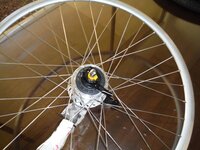 NesusInter701.JPG222.2 KB · Views: 297
NesusInter701.JPG222.2 KB · Views: 297 -
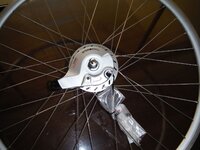 NexusInterMRollerBrake01.JPG220.3 KB · Views: 288
NexusInterMRollerBrake01.JPG220.3 KB · Views: 288 -
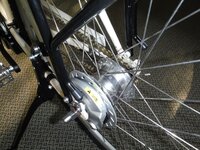 RaleighIDo13.JPG387.8 KB · Views: 303
RaleighIDo13.JPG387.8 KB · Views: 303 -
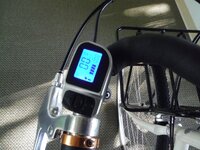 RaleighIDo14.JPG396 KB · Views: 273
RaleighIDo14.JPG396 KB · Views: 273 -
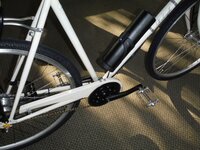 RaleighIDo16JPG.JPG375.4 KB · Views: 255
RaleighIDo16JPG.JPG375.4 KB · Views: 255 -
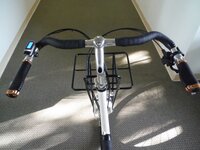 RaleighIDo17JPG.JPG315.9 KB · Views: 270
RaleighIDo17JPG.JPG315.9 KB · Views: 270 -
 RaleighIDo24JPG.JPG311.2 KB · Views: 255
RaleighIDo24JPG.JPG311.2 KB · Views: 255 -
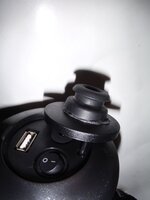 BatteryTop.JPG114.5 KB · Views: 279
BatteryTop.JPG114.5 KB · Views: 279
Last edited:
PedalUma
Well-Known Member
- Region
- USA
- City
- Petaluma, CA
Thanks for asking. These battery housings are out there. I have the internals made for me with premium cells and battery management chips. I cannot discuss my sources. It is vital that you never shift under power, only while stopped or coasting with a Nexus or Alfine hub. That Raleigh is a torque sensor bike with a smaller motor with greater range than the Bafang. It is stealthy. The Bafang would be easier for someone new to conversions to install on your frame because the pedals are in front of the seat tube on your bike and the lighter weight motors typically mount using the chain stays behind the bottom bracket. Yes, a similar style of battery will work with a Bafang, but Bafangs normally get larger batteries do to their higher expenditure rate of blead out.Thanks for the info. Didn’t know I didn’t need the gear senor or throttle with the internal hub. Btw, what type of battery is that.., and can it be used with the bafang mid drive?
Similar threads
- Replies
- 14
- Views
- 3K
- Replies
- 12
- Views
- 1K
- Replies
- 32
- Views
- 4K

